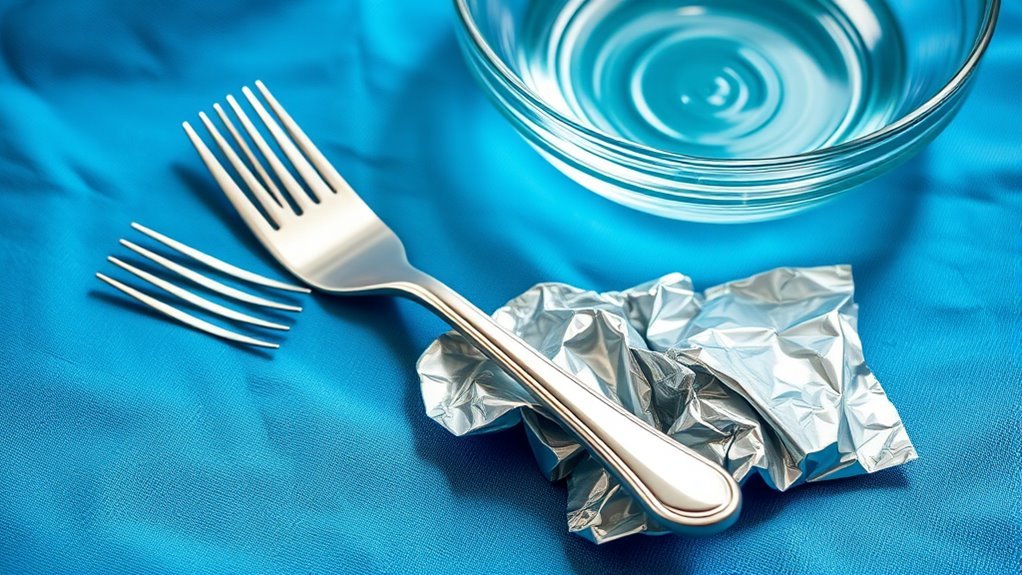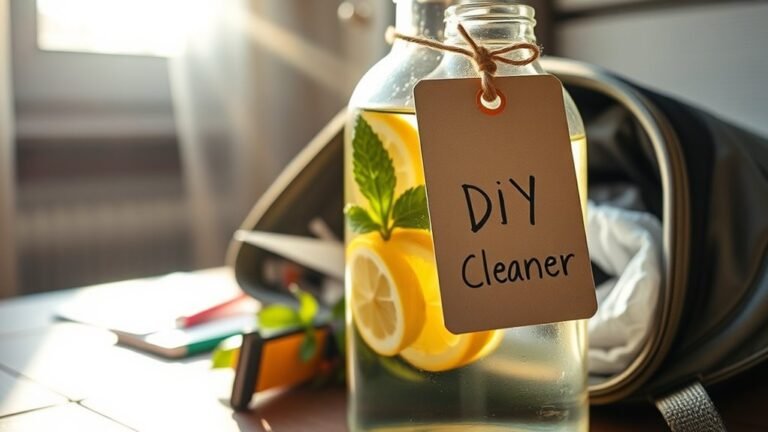Using Aluminum Foil for Cleaning Hacks
You can use aluminum foil in several clever cleaning hacks around your home. Crumple it to scrub rust off tools without harsh chemicals or remove stubborn grime from pots without scratching. It’s great for polishing silverware by lining a bowl with foil and adding baking soda to lift tarnish. You can even sharpen dull scissors by cutting through folded foil. Plus, it helps catch debris in drains and reduces static in laundry. There are plenty more handy uses to discover.
Removing Rust From Tools and Utensils

When you notice rust forming on your tools or utensils, aluminum foil can be a surprisingly effective solution. Instead of relying on harsh chemicals, crumple a small piece of foil and dip it in water or vinegar. Gently rub the rusted areas, and you’ll see the rust start to lift away. This simple rust removal technique not only saves you money but also keeps your tools in great shape. Using aluminum foil for rust removal is one of the best tool maintenance tips you can adopt—it’s quick, eco-friendly, and easy. Keeping your tools rust-free guarantees they last longer and perform better, giving you the freedom to work without interruption or frustration. Try this hack next time rust threatens your gear.
Cleaning Stubborn Pots and Pans
When you’re tackling tough residue on pots and pans, aluminum foil can be a game changer for scrubbing without scratching. Crumple it into a ball and gently scrub away burnt-on food with ease. This simple trick helps you keep your cookware clean and scratch-free at the same time.
Scrubbing Tough Residue
Although stubborn residue on pots and pans can be frustrating, aluminum foil offers a simple scrubbing solution you can rely on. When you’re tackling tough stains, crumple a piece of foil into a ball and gently scrub the affected area. Its texture is just abrasive enough for effective residue removal without damaging your cookware.
Here’s a quick guide to scrubbing tough residue with aluminum foil:
| Task | Tip |
|---|---|
| Tough stains | Use a tightly crumpled foil ball |
| Grease buildup | Add a little dish soap |
| Burnt residue | Soak with warm water first |
| Final rinse | Use a soft cloth to wipe |
This method gives you the freedom to clean stubborn pots and pans quickly and efficiently.
Preventing Scratches Effectively
Since stubborn pots and pans require extra effort to clean, you’ll want to prevent scratches that can worsen their condition. Scratch prevention is key to keeping your cookware in top shape. While aluminum foil is handy, it can sometimes be too abrasive. To protect your pots and pans without sacrificing cleaning power, consider these foil alternatives:
- Use a soft sponge or nylon scrubber to avoid harsh scratching.
- Try a paste of baking soda and water, which cleans gently yet effectively.
- Employ wooden or silicone utensils for scrubbing to minimize surface damage.
Polishing Silverware and Jewelry

Restore the shine of your silverware and jewelry quickly by using aluminum foil. You don’t need expensive silver polishing products to get brilliant results. Simply line a bowl with aluminum foil, add hot water, and mix in baking soda and salt. Submerge your tarnished silverware or jewelry in the solution, letting the natural chemical reaction lift away tarnish. This method is gentle yet effective, making it ideal for jewelry care without harsh scrubbing or chemicals. It frees you from costly cleaners and complicated routines, giving your precious items a refreshed look effortlessly. Embrace this simple hack and enjoy your sparkling silverware and jewelry, all while maintaining their integrity and beauty with minimal effort and maximum freedom.
Unclogging and Cleaning Drains
When your drains start to slow or clog, aluminum foil can be a surprisingly effective tool to help clear them. Instead of relying on harsh chemicals, you can use foil traps to catch debris and improve drain cleaning naturally. Here’s how you can free your pipes with foil:
- Crumple a piece of aluminum foil and push it gently into the drain to act as a trap for hair and grime.
- Pour boiling water over the foil to help loosen buildup stuck on the pipes.
- Repeat this process regularly to prevent stubborn clogs and maintain smooth drainage.
Sharpening Scissors and Blades

If your scissors or blades are feeling dull, aluminum foil can quickly bring back their sharpness. Just fold the foil several times to create a thick layer, then cut through it a few times to sharpen the edges. With a few simple maintenance tips, you’ll keep your tools performing like new.
Foil Folding Techniques
You can sharpen your scissors and blades easily using just a few folds of aluminum foil. By folding the foil into a compact shape, you create a surface that helps restore sharpness while embracing the spirit of foil origami and creative crafts. Here’s how to fold your foil for sharpening:
- Fold the foil multiple times until it’s thick and firm enough to provide resistance.
- Shape the folded foil into a small, flat square or rectangle for consistent cutting.
- Keep the edges neat to guarantee even sharpening without damaging your blades.
Using these foil folding techniques gives you a simple, eco-friendly way to maintain your tools while enjoying a bit of creative freedom. It’s a quick hack that blends practicality with the fun of crafty folding.
Blade Maintenance Tips
A sharp blade makes all the difference in your cutting tasks, and maintaining your scissors or knives doesn’t have to be complicated. One simple trick is folding a piece of aluminum foil several times and cutting through it repeatedly. This quick method hones the edges, giving your blades a sharper edge without extra tools. Regular blade care like this guarantees your tools stay effective and last longer. You’re not just saving money—you’re embracing freedom from constant replacements. Remember to clean your blades after sharpening to remove tiny metal scraps that could dull them again. By incorporating these easy steps, you maintain tool longevity effortlessly, keeping your scissors and knives ready whenever you need them. With minimal effort, you gain maximum freedom in your daily tasks.
Preventing Static and Wrinkles in Laundry
One simple trick to reduce static cling and wrinkles during laundry involves using aluminum foil balls. Toss a couple of these shiny orbs into your dryer, and you’ll notice a difference in both static reduction and wrinkle prevention. The foil discharges static electricity, freeing your clothes from clinginess and cuts down on wrinkles naturally.
Here’s why you’ll want to give it a try:
- Aluminum foil balls are reusable, making them eco-friendly and budget-conscious.
- They help your clothes dry faster, saving energy and time.
- They eliminate the need for chemical-laden dryer sheets, letting you enjoy fresh laundry without added scents or residues.
Embrace this easy hack and gain more freedom from frustrating static and wrinkles every laundry day.
Frequently Asked Questions
Can Aluminum Foil Be Used to Clean Glass Surfaces Safely?
Oh sure, go ahead and rub your glass with a crumpled ball of aluminum foil—because who doesn’t want their windows looking like a disco ball? In reality, aluminum foil’s abrasive nature might leave tiny scratches, sabotaging that glass shine you crave. If you want freedom from streaks and damage, you’re better off choosing foil alternatives like microfiber cloths or vinegar solutions. Keep your glass gleaming without sacrificing its smooth, clear surface!
Is Aluminum Foil Safe for Cleaning Electronic Screens?
You shouldn’t use aluminum foil to clean electronic screens because it can damage the screen protection layer, reducing cleaning efficiency and potentially causing scratches. Instead, stick to microfiber cloths and gentle screen cleaners to keep your devices safe and clear. Trust me, protecting your screen means maintaining your freedom to enjoy your gadgets without annoying damage or reduced visibility. So, skip the foil and choose safe cleaning methods for better results.
How Do You Dispose of Aluminum Foil After Cleaning?
When you’re done cleaning, don’t just toss that aluminum foil in the trash. You can recycle aluminum to keep things eco-friendly and free from unnecessary waste. Before foil disposal, make sure it’s clean and crumpled into a ball—that way, recycling centers can easily process it. Embracing recycling aluminum gives you freedom from guilt and helps protect the planet, so always check local guidelines and recycle whenever you can!
Can Aluminum Foil Remove Pet Hair From Furniture?
Did you know that over 67% of pet owners struggle with pet hair on their furniture? You can actually use aluminum foil to tackle this! By crumpling a piece into a ball and gently rubbing it over your furniture, the foil creates static electricity that attracts pet hair. It’s a simple, eco-friendly trick for furniture cleaning that frees you from sticky lint rollers and messy vacuums—giving you more time to enjoy your pet’s company.
Does Aluminum Foil Scratch Non-Stick Cookware During Cleaning?
You might worry about aluminum foil scratching your non-stick cookware during cleaning, but it can be risky. Non-stick durability depends on gentle care, and scrubbing with foil can damage that protective coating. Instead, you could opt for softer cookware alternatives like silicone scrubbers or nylon brushes, which keep your pans safe while still getting the job done. Protect your freedom to cook without worrying about ruining your gear!






